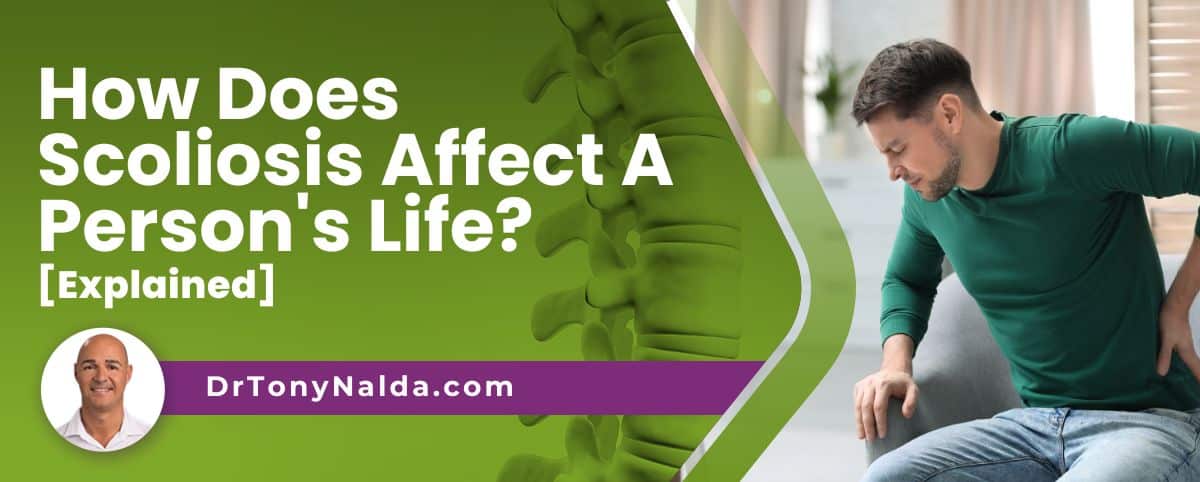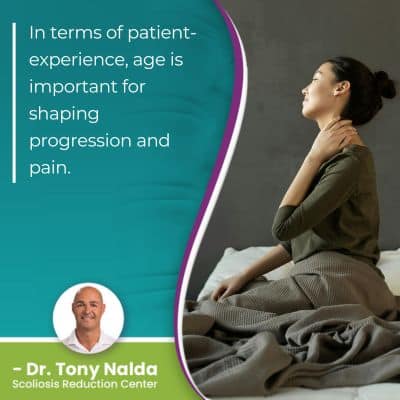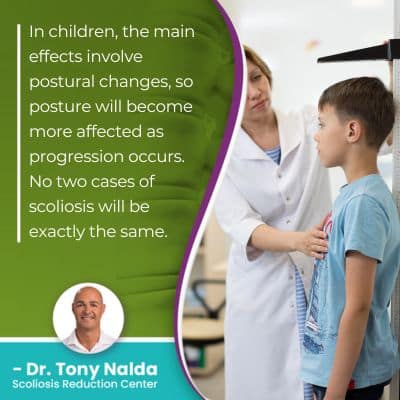How Does Scoliosis Affect A Person's Life? [Explained]

Factors that are known to shape a person's experience of life with scoliosis are the condition's classification points: patient age, condition severity, type, and curvature location. Continue reading to learn what each of these factors can indicate.
Cases of scoliosis are unique; what one patient experiences isn't always indicative of what others will face. How scoliosis can affect a person's life depends on a number of factors that vary from patient to patient, including the chosen treatment approach.
As a patient's scoliosis-journey starts with a diagnosis, let's start with what that involves.
Table of Contents
Diagnosing Scoliosis
Being diagnosed with scoliosis means an unnatural sideways curvature of the spine has developed, and the spine will also rotate unnaturally; this is what makes scoliosis a 3-dimensional condition and sets it apart from a number of other spinal conditions that cause a loss of healthy spinal curves.
Diagnosing scoliosis isn't always easy, but there are treatment benefits associated with early diagnosis and intervention.
Scoliosis is diagnosed through a physical examination that involves bending forward, and X-ray results to truly see what's happening in and around the spine, to confirm a rotational component, and to determine a patient's Cobb angle.
Because scoliosis is such a highly-variable condition, part of the diagnostic process involves comprehensive assessment to classify conditions based on a number of factors; this is done to streamline the treatment process and inform the customization of treatment plans.
Being diagnosed with scoliosis also means being diagnosed with a progressive condition whose nature is to get worse over time, and while we don't always know what causes scoliosis onset, growth is what triggers it to progress.
Scoliosis also affects all ages from babies to the elderly and every age in between, so let's start with patient age as the first classification point to shape how a patient is likely to experience life with the condition.
Patient Age
 In terms of patient-experience, age is important for shaping progression and pain.
In terms of patient-experience, age is important for shaping progression and pain.
As a progressive condition, the size of the unnatural spinal curve is virtually guaranteed to get larger over time, and as growth triggers progression, in children who are still growing, we know they have more potential progression to go through.
Adolescents are the most at risk for rapid-phase progression because of the unpredictable and rapid growth spurts of puberty, so patient age indicates how fast, or slowly, a patient's scoliosis is likely to progress.
Patient age is also important because as scoliosis doesn't become a compressive condition until adulthood has been reached, that's when it commonly starts to become painful.
Scoliosis pain can involve muscle pain, back pain, and pain that radiates throughout the body (arm pain and leg pain) because of nerve compression; it's pain that's the most noticeable symptom for adults, so patient age is a good indicator of whether or not pain management will be needed and whether pain will affect quality of life.
The more severe a patient's condition is, and the more rotation there is, the more painful it's likely to be.
Condition Severity
Condition severity is determined by a measurement known as Cobb angle, and this is determined during X-ray by drawing lines from the tops and bottoms of the curve's most-tilted vertebral bodies, and the resulting angle is expressed in degrees.
- Mild scoliosis involves a Cobb angle measurement of between 10 and 25 degrees
- Moderate scoliosis involves Cobb angle measurements of between 25 and 40 degrees
- Severe scoliosis involves measurements of 40+ degrees
- Very severe scoliosis involves a Cobb angle measurements of 80+ degrees
The higher a patient's Cobb angle, the more severe the condition, and this is a key piece of information needed for planning effective treatment plans, and it also tells me what likely symptoms of scoliosis a patient will experience.
In children, the main effects involve postural changes, so posture will become more affected as progression occurs.
Postural deviation can significantly affect an adolescent's life; most adolescents don't want to stand out or look different from their peers.
Adolescents want to fit in, they don't want to walk differently, and disruptions to gait, balance, and coordination are common effects that can also become more noticeable with progression.
So how severe a person's scoliosis is indicates what their life with scoliosis can look like, but remember, as a progressive condition, where a patient's scoliosis is at the time of diagnosis doesn't mean that's where it will stay; only proactive treatment can work towards counteracting a condition's progressive nature.
Condition Type
 Condition type is important for shaping a person's experience of life with scoliosis as well, partially because it can also indicate severity.
Condition type is important for shaping a person's experience of life with scoliosis as well, partially because it can also indicate severity.
Most cases of scoliosis involve idiopathic scoliosis, meaning unknown cause, but there are atypical types of scoliosis that are associated with known causes, and they can be particularly severe: neuromuscular scoliosis, degenerative scoliosis, and congenital scoliosis.
Neuromuscular scoliosis, for example, is caused by the presence of a larger neuromuscular condition such as muscular dystrophy, cerebral palsy, or spina bifida, and the underlying condition has to guide the design of treatment plans.
Atypical types are going to be more complex to treat as they tend to be more severe.
Degenerative scoliosis affects older adults and is caused by natural age-related spinal degeneration, and congenital scoliosis is caused by a malformed spine that develops in utero.
Condition type shapes the treatment approach and also what life can be like. With neuromuscular scoliosis, for example, as it can be particularly severe, some patients become wheelchair-bound and unable to walk on their own.
Once spinal degeneration starts, the spine becomes increasingly unstable and unbalanced so can be particularly painful for older adults, and babies born with congenital scoliosis often present with additional congenital abnormalities so need to be comprehensively assessed and monitored.
Curvature Location
Scoliosis can develop anywhere along the spine, and the three main sections are the cervical spine, the thoracic spine, and the lumbar spine.
Where scoliosis develops can indicate the types of symptoms a patient is likely to experience.
In most cases, the area of the body that's located the closest to an affected spinal section is going to feel the majority of the condition's direct effects.
For example, if I diagnose a patient with lumbar scoliosis, I can predict that sciatic nerve pain could become an issue; the sciatic nerve starts in the lower spine and extends down the back of the buttock, leg, and into the foot.
As the brain and spine work together to form the central nervous system, spinal conditions can cause a wide range of symptoms, and for many, nerve-related back pain can be debilitating, so treatment options include taking pressure off a nerve that's being compressed by an unnatural spinal curve.
There are also a number of different curvature types and patterns that make each case unique; the complex nature of scoliosis necessitates the complete customization of treatment plans.
So as you can see, with the many different variable that scoliosis is classified around, every patient will have their own unique experience of what life will be like; for some, scoliosis is mild and doesn't complicate life overly, but for others, particularly severe cases of scoliosis, or those that are left untreated, symptoms can be overt and disruptive.
Conclusion
The most important thing to know about scoliosis is that the best way to minimize its impact on a person's life is to treat it proactively; as a progressive condition, the best time to start treatment is always now.
Scoliosis will affect a person's life more if it's not addressed; if left untreated, scoliosis is associated with complications: digestive issues, difficulty breathing, mental health issues, neurological deficits, and chronic back pain.
The main effects of scoliosis on children include postural changes such as uneven shoulders, uneven shoulder blades (one shoulder blade protruding more on one side), uneven hips, the development of a rib cage arch, ribs sticking out more on one side, and an uneven waist.
If scoliosis is left untreated, body image issues can develop; it's important to remember that the mental effects of a condition should also be considered.
There are several factors that shape a person's life with scoliosis, just like there are several factors that shape the crafting of effective treatment plans, and how a person's life will be affected is partially up to the person: how do you want to respond to a diagnosis? Are you going to treat it proactively? Are you going to merely watch and wait to see if it gets worse?
There are condition aspects out of a patient's control, for certain, but what is within their control is how to respond to the diagnosis, and this is the most important thing because how scoliosis is treated will shape the spine's long-term health and function.
Here at the Scoliosis Reduction Center, I approach each case as an opportunity to improve that patient's overall quality of life, and the best means of doing that is to address scoliosis proactively with comprehensive and customized treatment plans.
Dr. Tony Nalda
DOCTOR OF CHIROPRACTIC
After receiving an undergraduate degree in psychology and his Doctorate of Chiropractic from Life University, Dr. Nalda settled in Celebration, Florida and proceeded to build one of Central Florida’s most successful chiropractic clinics.
His experience with patients suffering from scoliosis, and the confusion and frustration they faced, led him to seek a specialty in scoliosis care. In 2006 he completed his Intensive Care Certification from CLEAR Institute, a leading scoliosis educational and certification center.
About Dr. Tony Nalda
 Ready to explore scoliosis treatment? Contact Us Now
Ready to explore scoliosis treatment? Contact Us Now





